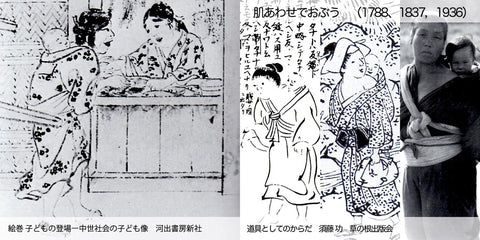Onbuhimo History
Onbuhimos originated from a Japanese style baby carrier. Where "onbu" translates as "back, piggyback, or to carry on one's back" and "himo" translates as long, thin strap or sash. The term onbuhimo originally meant high back-carry utilizing a himo tied over a kimono (robe or jacket), where the baby was under the kimono next to the parent and the himo strap was tied over the kimono to secure the baby to the wearer.

More modern Onbuhimo designs were commercialized in Japan in the late 1960s utilizing a panel for baby's back, fabric loops, and himo-type straps to run under baby's legs to create a seat. These early Onbuhimo sometimes featured waist-belts as well.

From exchanges with Japanese researchers on the subject of the history of Onbuhimo the important features of the original Japanese design seem to be that the baby be in a high enough position to interact with the world and caregiver over the shoulder of the wearer.
This history was written with help from the Japanese Babywearing Group. Specific thanks goes to Masayo Sonoda for her many conversations.
http://babywearing.co.jp/onbu.html
http://www.babywearing.jp/blog/2016/05/07/453
